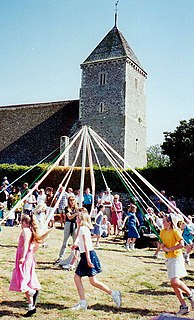
May Day is a public holiday in some regions, usually celebrated on 1 May or the first Monday of May. It is an ancient festival marking the first day of summer, and a current traditional spring holiday in many European cultures. Dances, singing, and cake are usually part of the festivities.
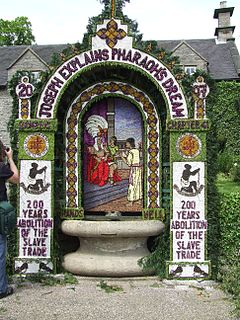
Well dressing, also known as well flowering, is a tradition practised in some parts of rural England in which wells, springs and other water sources are decorated with designs created from flower petals. The custom is most closely associated with the Peak District of Derbyshire and Staffordshire. James Murray Mackinlay, writing in 1893, noted that the tradition was not observed in Scotland; W. S. Cordner, in 1946, similarly noted its absence in Ireland. Both Scotland and Ireland do have a long history of the veneration of wells, however, dating from at least the 6th century.

A maypole is a tall wooden pole erected as a part of various European folk festivals, around which a maypole dance often takes place.
Midsummer is the period of time in the middle of the summer. The exact dates vary among different cultures, but is primarily held close to the summer solstice. The celebration predates Christianity, and has existed under different names and traditions around the world.

Castleton is a village in the High Peak district of Derbyshire, England, at the western end of the Hope Valley on the Peakshole Water, a tributary of the River Noe, between the Dark Peak to the north and the White Peak to the south. The population was 642 at the 2011 Census.

Marzanna, Morė, Marena, Mara, Morana, Morena or Mora is a pagan Slavic goddess associated with seasonal rites based on the idea of death and rebirth of nature. She is an ancient goddess associated with winter's death, rebirth and dreams. In ancient Slavic rites, the death of the Goddess Marzanna at the end of winter becomes the rebirth of Spring of the Goddess Kostroma (Russian), Lada or Vesna representing the coming of Spring.

Restoration Day, more commonly known as Oak Apple Day or Royal Oak Day, was an English public holiday, observed annually on 29 May, to commemorate the restoration of the English monarchy in May 1660. In some parts of the country the day is still celebrated. It has also been known as Shick Shack Day, or Oak and Nettle Day.

In the British Isles and parts of the Commonwealth, the May Queen or Queen of May is a personification of the May Day holiday, and of springtime and also summer. The May Queen is a girl who rides or walks at the front of a parade for May Day celebrations. She wears a white gown to symbolise purity and usually a tiara or crown. Her duty is to begin the May Day celebrations. She is generally crowned by flowers and makes a speech before the dancing begins. Certain age-groups dance around a Maypole celebrating youth and springtime.

The Green Knight is a character from the 14th-century Arthurian poem Sir Gawain and the Green Knight and the related medieval work The Greene Knight. His true name is revealed to be Bertilak de Hautdesert in Sir Gawain, while The Greene Knight names him "Bredbeddle". The Green Knight later features as one of Arthur's greatest champions in the fragmentary ballad "King Arthur and King Cornwall", again with the name "Bredbeddle".

Jack in the Green, also known as Jack o' the Green, is an English folk custom associated with the celebration of May Day. It involves a pyramidal or conical wicker or wooden framework that is decorated with foliage being worn by a person as part of a procession, often accompanied by musicians.
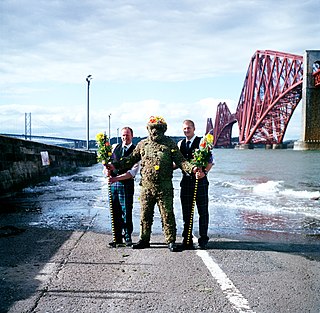
The Burryman or Burry Man is the central figure in an annual ceremony or ritual, the Burryman's Parade, that takes place in the South Queensferry area of Edinburgh, on the south bank of the Firth of Forth in Scotland, on the second Friday of August.
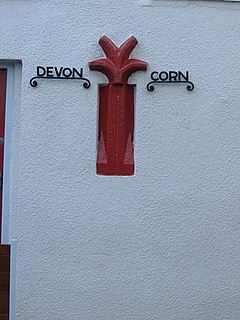
Kingsand and Cawsand are twin villages in southeast Cornwall, United Kingdom. The villages are situated on the Rame Peninsula and are in the parish of Maker-with-Rame.
The Bower is well known in Lichfield, England and nearby areas. It is a festival held each spring on a bank holiday. It is about 800 years old. A statute of Henry II of England (1134-1159) ordered that all men capable of bearing arms should be inspected by the magistrates. Since there was no standing army, this was a way to find out how many men could fight in a war. The men would then march through the streets and retire at a "Bower House" for roast beef and spirits. This ensured a good turn-out.
Festive ecology explores the relationships between the symbolism and the ecology of the plants, fungi and animals associated with cultural events such as festivals, processions, and special occasions. Examples of topics are given below.
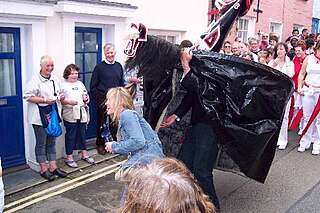
The 'Obby 'Oss festival is a folk custom that takes place each May Day in Padstow, a coastal town in North Cornwall. It involves two separate processions making their way around the town, each containing an eponymous hobby horse known as the 'Obby 'Oss.

Rushbearing is an old English ecclesiastical festival in which rushes are collected and carried to be strewn on the floor of the parish church. The tradition dates back to the time when most buildings had earthen floors and rushes were used as a form of renewable floor covering for cleanliness and insulation. The festival was widespread in Britain from the Middle Ages and well established by the time of Shakespeare, but had fallen into decline by the beginning of the 19th century, as church floors were flagged with stone. The custom was revived later in the 19th century and is kept alive today as an annual event in a number of towns and villages in the north of England.

The term "hobby horse" is used, principally by folklorists, to refer to the costumed characters that feature in some traditional seasonal customs, processions and similar observances around the world. They are particularly associated with May Day celebrations, mummers' plays and the Morris dance in England.

Czech folklore is the folk tradition which has developed among the Czech people over a number of centuries. Czech folklore was influenced by a mix of Christian and pagan customs. Nowadays it is preserved and kept alive by various folklore ensembles uniting members of all ages, from children to seniors, showing their talent during competitions, folklore festivals or other performances.
English festivals are the Christian and secular festivals that are traditionally celebrated in England. Most festivals are observed throughout England but some, such as Oak Apple Day, Souling, Rushbearing, Bawming the Thorn, and Hocktide are local to certain regions.
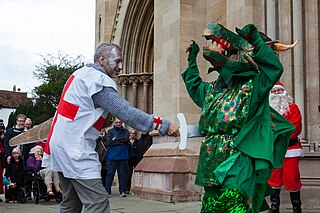
Mummers' plays are folk plays performed by troupes of amateur actors, traditionally all male, known as mummers or guisers. Historically, mummers' plays consisted of informal groups of costumed community members that visited from house to house on various holidays. Today the term refers especially to a play in which a number of characters are called on stage, two of whom engage in a combat, the loser being revived by a doctor character. This play is sometimes found associated with a sword dance though both also exist in Britain independently.


























